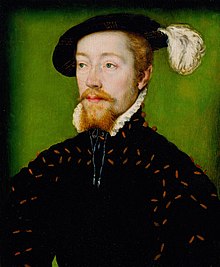
Back Jakobus V van Skotland Afrikaans Iacobus V Scotta Cyning ANG جيمس الخامس ملك إسكتلندا Arabic جيمس الخامس ملك اسكتلندا ARZ V Ceyms Azerbaijani بئشینجی جیمز (ایسکاتلند) AZB Якаў V Byelorussian Джеймс V Bulgarian Jakov V, kralj Škota BS Jaume V Catalan
| James V | |
|---|---|
 Portrait by Corneille de Lyon, c. 1536 | |
| King of Scotland | |
| Reign | 9 September 1513 – 14 December 1542 |
| Coronation | 21 September 1513 |
| Predecessor | James IV |
| Successor | Mary |
| Regents | See list
|
| Born | 10 April 1512 Linlithgow Palace, Linlithgow, Scotland |
| Died | 14 December 1542 (aged 30) Falkland Palace, Fife, Scotland |
| Burial | 8 January 1543 |
| Spouses | |
| Issue more... | |
| House | Stewart |
| Father | James IV of Scotland |
| Mother | Margaret Tudor |
| Religion | Catholicism |
| Signature |  |
James V (10 April 1512 – 14 December 1542) was King of Scotland from 9 September 1513 until his death in 1542. He was crowned on 21 September 1513 at the age of seventeen months. James was the son of King James IV and Margaret Tudor, daughter of Henry VII of England. During his childhood Scotland was governed by regents, firstly by his mother until she remarried, and then by his first cousin once removed, John Stewart, Duke of Albany. James's personal rule began in 1528 when he finally escaped the custody of his stepfather, Archibald Douglas, 6th Earl of Angus. His first action was to exile Angus and confiscate the lands of the Douglases.
James greatly increased his income by tightening control over royal estates and from the profits of justice, customs and feudal rights. He founded the College of Justice in 1532 and also acted to end lawlessness and rebellion in the Borders and the Hebrides. The rivalry among France, England and the Holy Roman Empire lent James unwonted diplomatic weight, and saw him secure two politically and financially advantageous French marriages, first to Madeleine of Valois and then to Mary of Guise. James also fathered at least nine illegitimate children by a series of mistresses.
James's reign witnessed the beginnings of Protestantism in Scotland, and his uncle Henry VIII of England's break with Rome in the 1530s placed James in a powerful bargaining position with the papacy, allowing James to exploit the situation to increase his control over ecclesiastical appointments and the financial dividends from church revenues. Pope Paul III also granted him the title of Defender of the Faith in 1537. James maintained diplomatic correspondence with various Irish nobles and chiefs throughout their resistance to Henry VIII in the 1530s, and in 1540 they offered him the kingship of Ireland. A patron of the arts, James spent lavishly on the construction of several royal residences in the High Gothic and Renaissance styles.
James has been described as a vindictive king, whose policies were largely motivated by the pursuit of wealth, and a paranoid fear of his nobility which led to the ruthless appropriation of their lands. He has also been characterised as the "poor man's king", due to his accessibility to the poor and his acting against their oppressors. James died in December 1542 following the Scottish defeat by the English at the Battle of Solway Moss. His only surviving legitimate child, Mary, succeeded him at the age of just six days old.